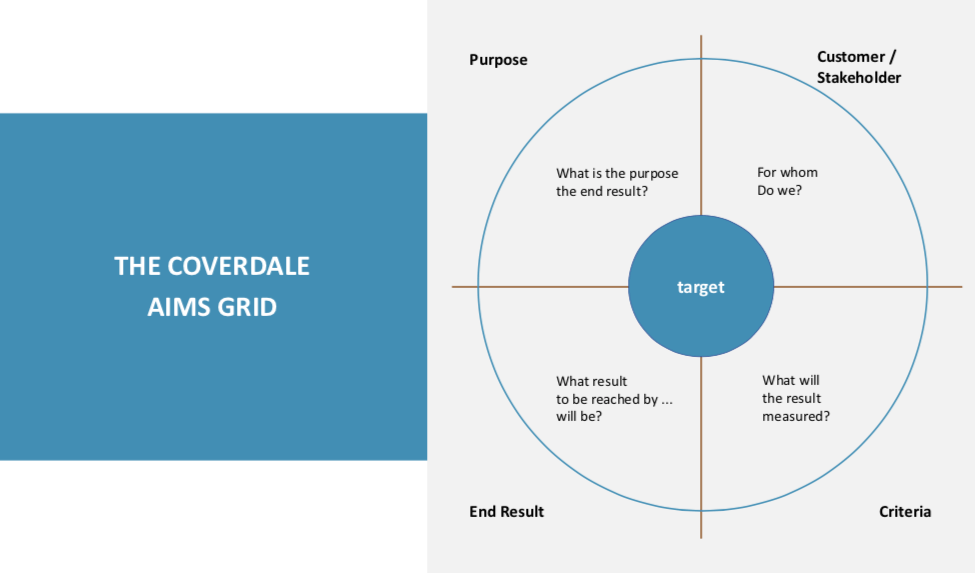Our world is fast moving, changes are no longer predictable. In our daily work, we constantly face the challenge of combining fast pace, complexity and quality.
You might think it makes no sense to think about goals in these dynamic times. Circumstances change so quickly that goals are no longer sustainable.
Do you know the phenomenon? You sit together with your team to tackle a change. This is followed by discussions about how this should be done. Finally, a compromise is reached, the plan is now to be transferred into the working reality.
In many teams it happens again and again – the picture of the big picture is neither defined exactly nor communicated and therefore nobody knows about the exact overall orientation. What often follows is that the employees lose their motivation because they cannot see the meaning behind their activities.
The founder of Coverdale, Ralf Coverdale, recognized as early as the 1950s that a project can only be successfully started with a clear, jointly agreed target agreement. This was the early period of project management: new challenges such as lateral leadership demanded new forms of cooperation.
To work effectively and efficiently, it was necessary to agree on a common goal. Ralph Coverdale developed three key questions to achieve this in order to clarify the objectives:
1. What is the purpose of the final result?
2. what should be available by the time …?
3. how will the final result be measured?
In the 1980s, together with the customer Hewlett Packard, who was then the worldwide opinion leader on the subject of customer orientation, a fourth question was added to this set of questions.
4. Who are we doing this for?
extended and visualized.
That was the beginning of the Coverdale target, which has lost nothing of its importance after 50 years. With these four guiding questions in the individual segments, it is possible to grasp all relevant aspects of a goal at a glance and to show the dependencies between the fields.

The Coverdale target is divided into four areas, sense/purpose, client/stakeholder, end result and criteria, which are discussed with the corresponding key questions. The arrows in the middle show the dependency between the individual fields.
1. The question about the STAKEHOLDERS: “Who are we doing this for?
Who is the client, who are the stakeholders? Here, it is important to fully record all persons who are involved in the clarification of a goal or who are affected by the result of a goal.
2. The question about the SENSE/ PURPOSE: “What is the final result for?
In both the private and the professional context, the question of meaning plays a central role. If there is no sense in the personal sphere, a feeling of emptiness or meaninglessness can sometimes spread. The psychologist Mihaly Csikszentmihalyi said that sense fulfilment provides the activation energy for our lives.
But the lack of meaning can also have massive negative effects in professional areas. If sense and purpose are not clearly defined, time and money are often invested without achieving the desired success.
The question of the meaning and purpose of a goal is of great importance in the definition of goals. It is, so to speak, the heart of every goal work. To create clarity in this question contributes a substantial part to the success of the whole project.
In this context, it is necessary to look closely at all stakeholders (customers, employees, etc.) and examine in turn the purpose of each stakeholder. One can assume that the purposes of the individual stakeholders will always differ from each other. The larger the project and thus the goal, the more intensively one should deal with this question.
Regardless of whether it is a project order, a negotiation situation or a decision to be made: this question always makes it possible to clarify the order.
The clarification of the order is closely related to the stakeholder or customer, because the purposes of all customers must be taken into account in order to clarify the objectives properly.
3. the question about the final result: “What should be available by the time …”?
The final result defines which result is to be achieved by when. All arrows come together in this segment, i.e. the defined purpose, the stakeholders and the defined criteria have a strong influence on what is to be achieved at the end of the project.
4. the question about the CRITERIA OF SUCCESS: “By what is the final result measured?
The criteria to be fulfilled in the contract are agreed with the customer/stakeholder. They are defined by the stakeholders and provide the answers to the questions that the stakeholders should be asked. The criteria relate to the sense and purpose of the objectives. In any case, aspects of quality, time and resources should be considered in this question. These criteria are also used for the “Quality Check” once the goal has been achieved.
There is an interdependent relationship between the four fields of the Coverdale target, which is represented by arrows in the sketch. If a parameter in the Coverdale target changes, there will be cross-segment movements and this one, possibly small change can have effects on all other areas of the system. Therefore, it is necessary to constantly keep an eye on all four areas and to constantly question whether the contents are coordinated and still fit together.
It is important to have clarity about the goals so that they can be quickly adapted to changing requirements. You get this clarity when you have precisely defined the goals and thus have an overview of the individual components of a goal.
Clearly and completely formulated goals thus become a powerful instrument – even and especially in uncertain times.


Recent Comments